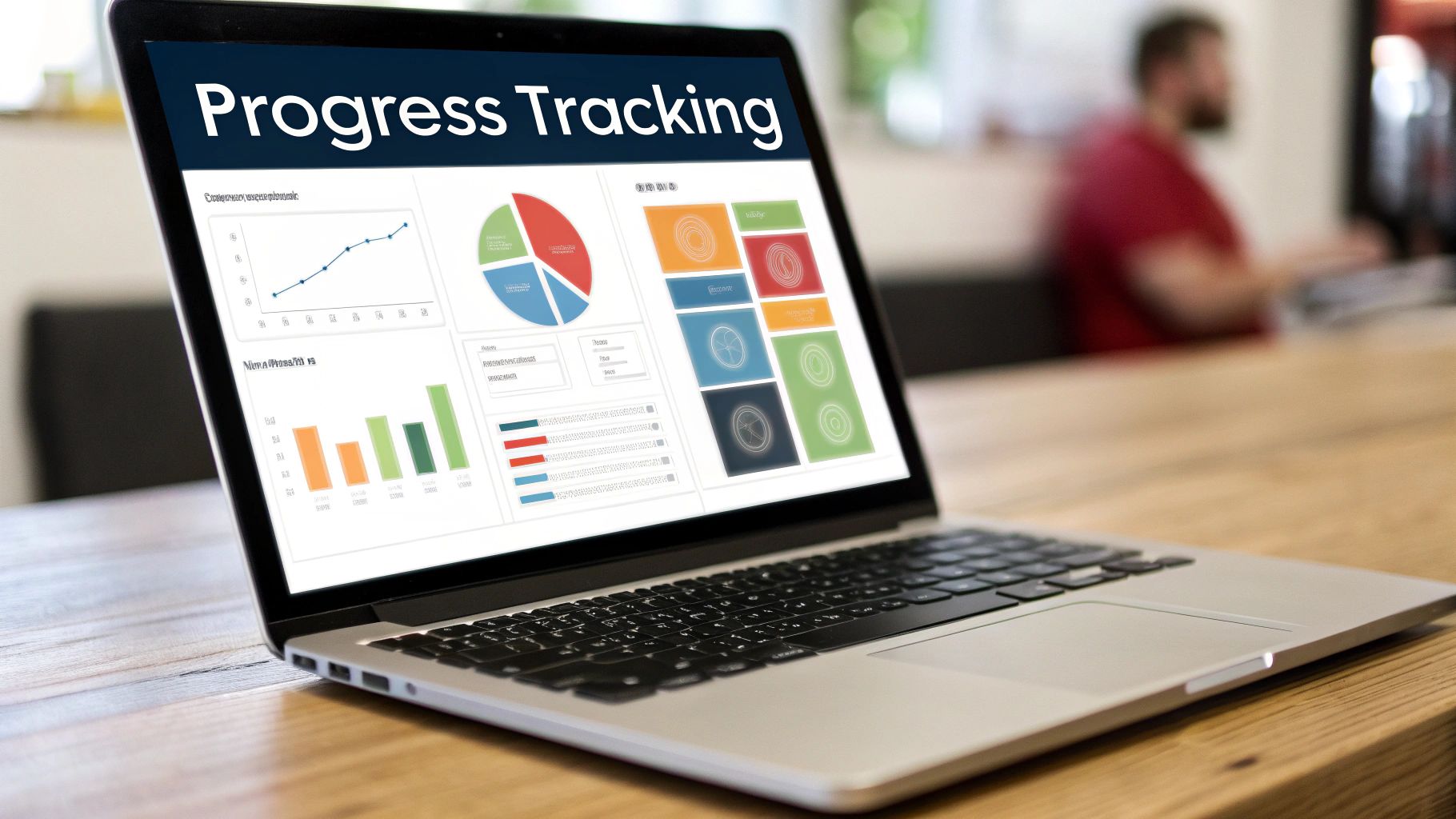Product Roadmap Best Practices: The Ultimate Guide to Strategic Planning Success
Understanding Modern Product Roadmap Fundamentals

Product roadmaps serve as essential strategic guides that help teams stay focused on their goals while coordinating development efforts. A well-crafted roadmap does more than just list upcoming features - it creates alignment around product vision and helps teams make smart decisions about what to build next.
Aligning Your Roadmap With Your Vision
The foundation of any strong roadmap starts with a clear product vision that acts as your guiding light. Before adding features to your roadmap, ask whether each one moves you closer to achieving your core mission. For example, if you're building project management software focused on ease of use, your roadmap should emphasize features that make complex workflows simpler and more intuitive.
Prioritizing Features Effectively
Smart prioritization helps teams invest their limited resources in the features that matter most. Many product teams use frameworks like the RICE scoring model - which evaluates potential features based on Reach, Impact, Confidence, and Effort - to make objective decisions. This data-driven approach ensures you're focusing development efforts on initiatives that deliver the most value. Teams should balance quick wins with longer-term strategic investments.
Embracing Flexibility and Iteration
Modern roadmaps need built-in flexibility to adapt as market conditions and customer needs evolve. Research shows that over two-thirds of product managers update their roadmaps monthly, with many doing so weekly. These frequent updates allow teams to respond to changing market dynamics and incorporate new customer feedback. For example, if usage data reveals different priorities than initially assumed, the roadmap can shift accordingly. Read more about roadmap best practices here: Learn more about successful roadmaps.
Communicating Clearly With Stakeholders
Clear communication keeps everyone aligned around roadmap goals and progress. Make your roadmap easily accessible and present information in ways that resonate with different audiences - executives want high-level strategy while engineers need technical details. Regular check-ins help ensure all stakeholders understand upcoming priorities and can provide timely input. This open dialogue maintains momentum and helps avoid misalignment between teams.
Transforming Data Into Strategic Roadmap Decisions

Product teams need data to guide their roadmap decisions effectively. The best teams combine both numbers and user feedback to truly understand what customers need and how markets are evolving. This evidence-based approach helps teams choose which features will have the biggest impact on product growth.
Identifying and Tracking Key Metrics
Success starts with focusing on metrics that directly connect to your goals. Rather than getting overwhelmed with too much data, zero in on the numbers that matter most for your product vision. For example, Pull Checklist tracks essential metrics like monthly recurring revenue, customer churn rate, and how often people use key features. These measurements reveal clear patterns in how customers interact with the product.
Implementing Effective Feedback Loops
Getting useful data requires ongoing conversations with users. Regular surveys, interviews, and in-product feedback tools help capture the real story behind the numbers. For instance, when Pull Checklist users share why they do or don't use certain features in their code review process, it provides vital context for future development plans.
Translating User Behavior into Action
Raw data only becomes valuable when it guides concrete improvements. For example, if many Pull Checklist users stop using the product before trying automated checklists, that might signal a need for better onboarding. By studying how people actually use the application, teams can build features that keep users engaged and coming back.
Product teams should base roadmap choices on clear evidence from multiple sources - usage data, customer feedback, and market research. Key metrics like Customer Lifetime Value, retention rates, and churn rates show how well the product meets user needs over time. High retention suggests you're on the right track, while increased churn highlights areas needing attention. Learn more about this approach: Discover more insights about data product roadmaps.
Balancing Competing Data Points
Sometimes different data points suggest different priorities. Using frameworks like weighted scoring helps teams evaluate trade-offs between impact, effort required, and confidence in the data. This structured method leads to more objective decisions that serve both user needs and business goals while supporting sustainable growth.
Mastering Strategic Feature Prioritization

Product teams often struggle with deciding which features to build next. A systematic approach using proven frameworks can help make these decisions clearer and more objective. The RICE Scoring Model has emerged as a practical tool that evaluates potential features using four key metrics - Reach, Impact, Confidence, and Effort. This data-driven method helps teams assess each feature's true value without relying on gut feel. For a deeper look at product planning, check out this detailed guide to product roadmaps.
Balancing Immediate Impact with Long-Term Value
Making smart feature choices means finding the right mix between quick wins and strategic investments. Think of it like tending a garden - some plants need attention now for a fast harvest, while others take time to mature but provide lasting value. The best product teams carefully plant both types of "seeds," ensuring they can show results today while building for tomorrow's growth.
Managing Stakeholder Expectations
Clear communication with stakeholders is key to successful feature prioritization. Using a structured scoring system like RICE helps explain decisions with hard data rather than opinion. When stakeholders understand how choices connect to business goals, they're more likely to support the plan. This shifts discussions from "my feature vs. your feature" to "what serves our shared objectives best."
Approaches to Handling Conflicting Priorities
Feature requests will inevitably compete for limited resources. Regular review sessions let teams adjust plans based on new market data and changing needs. This keeps your roadmap current and practical while staying focused on core objectives. Be ready to reprioritize when needed, but avoid constant changes that can derail progress.
Building and following a balanced product roadmap does more than drive growth - it creates alignment between what customers need and what the business wants to achieve. By using these prioritization practices, teams can make better choices about what to build next and deliver more value to users and stakeholders alike.
Building Effective Roadmap Communication Strategies

Getting everyone on the same page about your product roadmap takes careful planning. Each group of stakeholders - from the C-suite to developers - needs information presented in a way that resonates with their specific needs and priorities. With the right approach to communication, teams can stay aligned and move forward together, even when plans shift.
Speaking the Right Language for Each Audience
Different stakeholders care about different aspects of the roadmap:
- Executives want to understand how roadmap decisions connect to business goals and strategy
- Development Teams need clear technical requirements and realistic timelines to plan their work
- Marketing and Sales Teams focus on features and benefits they can highlight to customers
Creating focused versions of the roadmap for each group helps ensure everyone understands what matters most to them while staying connected to the bigger picture.
Handling Changes with Transparency
When market conditions or internal priorities force roadmap changes, open communication becomes essential:
- Share updates promptly with clear explanations of what's changing and why
- Ask for input from key stakeholders to inform roadmap adjustments
- Frame changes positively by highlighting lessons learned and opportunities ahead
For example, if you need to delay a feature launch, explain how reallocating those resources will deliver more value in another area that better serves current business needs.
Learning from Success Stories
Companies like Buffer excel at roadmap communication by always connecting planned work back to their core product vision. HubSpot actively seeks stakeholder feedback to ensure their roadmap aligns with what customers and internal teams really need.
Making Communication Clear and Consistent
Follow these proven approaches to keep everyone informed and engaged:
- Show, don't just tell: Use visuals and diagrams to explain complex roadmap concepts
- Meet regularly: Schedule standing updates to keep information flowing
- Welcome feedback: Create easy ways for stakeholders to share input and ideas
The key to effective roadmap communication is thoughtfully considering what each audience needs to know and delivering that information clearly and consistently. When everyone understands both the plan and their role in it, teams can work together more smoothly toward shared product goals.
Creating Living, Breathing Product Roadmaps
A great product roadmap is never static - it's a dynamic tool that grows and changes with your business needs while keeping teams focused on long-term objectives. Think of it like a compass that actively adjusts its heading based on new discoveries and market conditions.
Implementing Effective Review Cycles
Regular roadmap reviews are essential for success. A recent study found that over 65% of product managers update their roadmaps monthly, with many doing so weekly. This consistent review process helps teams:
- Keep pace with changing market conditions
- Incorporate new customer feedback quickly
- Make data-driven adjustments to priorities
Balancing Flexibility and Stability
Finding the sweet spot between adaptability and consistency is key:
- Be ready to adjust plans based on clear customer needs and market shifts
- Maintain a steady core vision that stakeholders can rely on
- Make changes thoughtfully and with purpose
Managing Strategic Pivots
Sometimes bigger changes are needed when initial plans aren't working:
- Set specific metrics that indicate when pivots may be needed (like rising churn rates)
- Track user engagement trends carefully
- Keep open communication with stakeholders about potential shifts in direction
Ensuring Stakeholder Alignment
Your roadmap should be a trusted guide for everyone involved:
- Schedule regular check-ins with different stakeholder groups
- Tailor updates for different audiences (executives vs development teams)
- Show how each change connects to the bigger product vision
Using Frameworks for Strategic Decisions
Put practical frameworks in place to guide your process:
- Track clear success metrics that matter to your business
- Use tools like Pull Checklist to monitor development health
- Develop clear criteria for evaluating potential changes
By treating your product roadmap as a living document that evolves thoughtfully over time, you create a powerful tool that keeps everyone aligned and moving toward shared goals.
Navigating Common Roadmap Challenges
Building a great product roadmap requires constant attention and refinement. Even with careful planning, every product team faces obstacles that can derail their progress. Learning from experienced teams about how to handle these common challenges can help you create a roadmap that truly moves your product forward.
Battling Feature Bloat
Feature bloat happens when product teams try to pack too many features into their roadmap. This often stems from wanting to please every stakeholder and implement every user request. For example, a project management tool might try to add every integration users ask for, spreading the development team thin and neglecting core product improvements.
To fight feature bloat, make tough choices about what to build. Use frameworks like the RICE scoring model to evaluate each feature's potential impact versus development effort. This helps teams focus resources on the most valuable work and confidently say "no" to less important requests.
Maintaining Strategic Focus Amidst Shifting Priorities
Markets and customer needs change quickly, which can make your carefully planned roadmap feel outdated. Like a ship adjusting its route through changing winds and currents, your roadmap needs to stay flexible while keeping sight of key objectives.
Set up regular roadmap reviews - weekly or bi-weekly - to evaluate progress and incorporate new insights. This keeps your roadmap relevant and useful rather than letting it become a stale document that no one follows.
Managing Scope Creep
Scope creep occurs when projects gradually expand beyond their original boundaries. Small additions may seem harmless on their own, but they add up to major delays and cost overruns. It's like online shopping where adding "just one more thing" to your cart leads to spending far more than planned.
Define clear scope and acceptance criteria for each roadmap item up front. Track changes through version control so you can understand their cumulative impact. This visibility helps prevent uncontrolled expansion of work.
Ensuring Stakeholder Alignment
When stakeholders pull in different directions, it creates confusion and wastes effort. For instance, sales might expect a certain feature by quarter-end while engineering focuses on different priorities. These misalignments lead to missed expectations and frustrated teams.
The key is clear, consistent communication with all stakeholders. Create targeted roadmap views that match different needs - executives want strategic overviews while developers need technical details. Regular updates and proactive discussion of concerns keeps everyone working toward shared goals.
